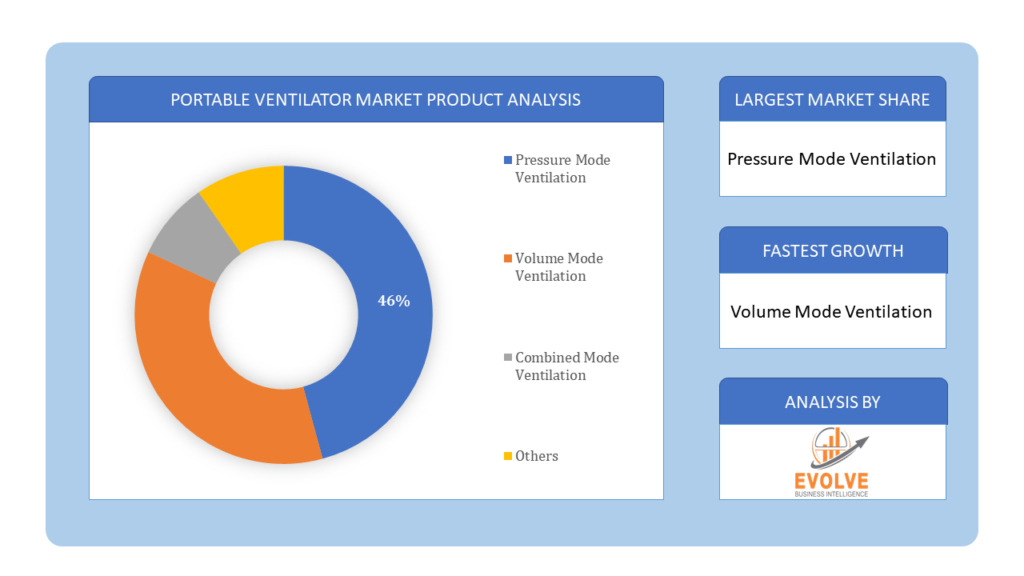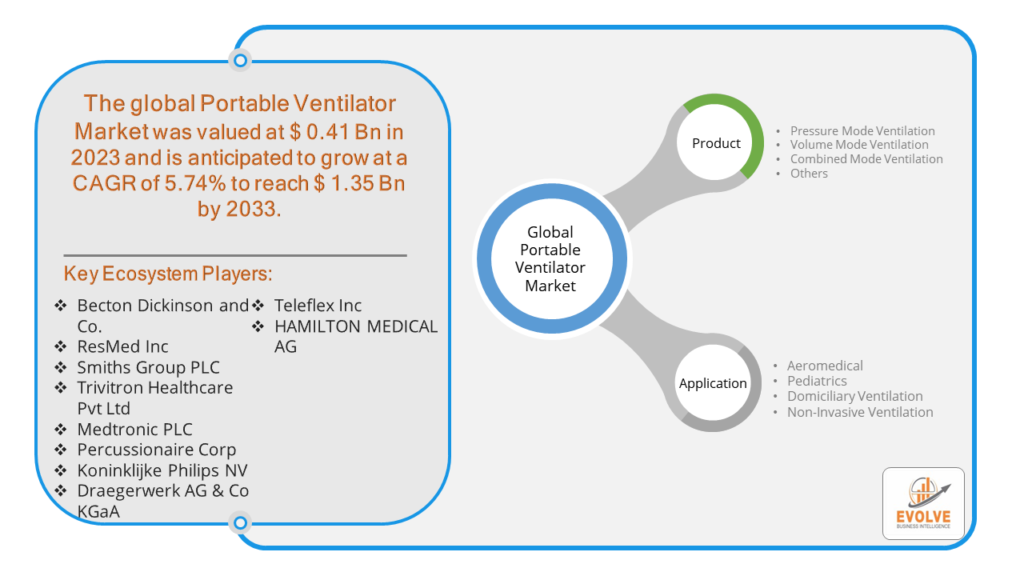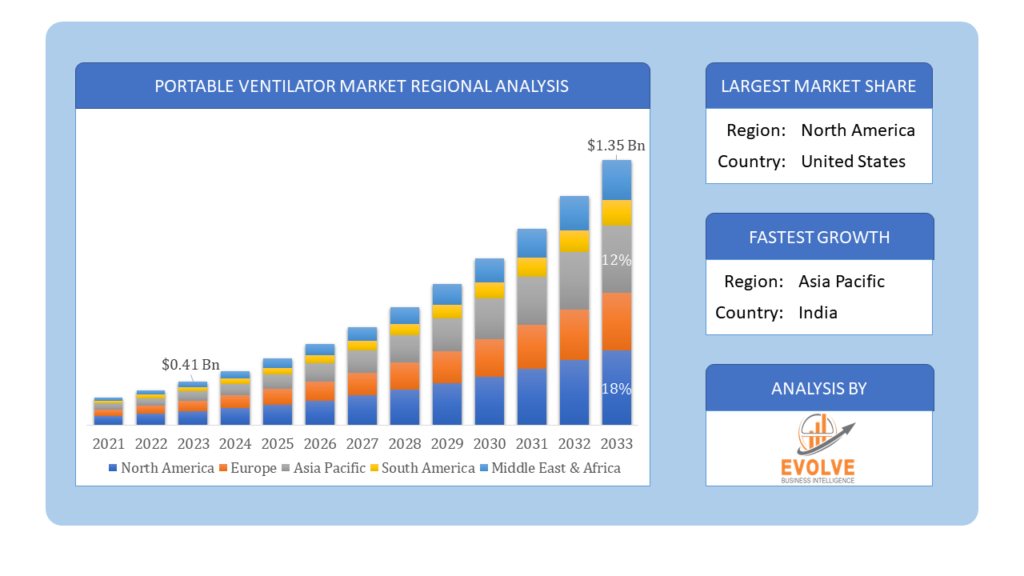Portable Ventilator Market Overview
The Portable Ventilator Market Size is expected to reach USD 1.35 Billion by 2033. The Portable Ventilator industry size accounted for USD 0.41 Billion in 2023 and is expected to expand at a compound annual growth rate (CAGR) of 5.74% from 2023 to 2033. The portable ventilator market refers to the segment of medical devices designed for respiratory support outside traditional hospital settings. These devices are lightweight, battery-operated, and offer flexibility for use in emergency medical services, home care settings, and during patient transport. Growing demand is driven by trends such as an aging population, increasing prevalence of chronic respiratory diseases, and advancements in technology making these devices more efficient and user-friendly. Key players in the market include medical device companies focusing on innovation in portable respiratory care solutions to meet evolving healthcare needs globally.
Global Portable Ventilator Market Synopsis
The COVID-19 pandemic has led to supply chain disruptions leading to supply shortages or lower demand in the portable ventilator market. The travel restrictions and social-distancing measures have resulted in a sharp drop in consumer and business spending and this pattern is to continue for some time. The end-user trend and preferences have changed due to the pandemic and have resulted in manufacturers, developers, and service providers to adopt various strategies to stabilize the company.
Portable Ventilator Market Dynamics
The major factors that have impacted the growth of Portable Ventilator are as follows:
Drivers:
Ø Technological Advancements
Advances in technology have significantly enhanced the capabilities of portable ventilators. These devices are now lighter, more compact, and equipped with sophisticated features such as advanced algorithms for precise ventilation management and monitoring. This technological evolution makes them safer, more efficient, and easier to use, thereby expanding their applicability across different healthcare settings.
Restraint:
- Limited Performance Compared to ICU Ventilators
Portable ventilators often have limitations in terms of ventilatory modes, tidal volume delivery, and advanced monitoring capabilities compared to intensive care unit (ICU) ventilators. This restricts their use to less acute patients or those requiring shorter-term ventilation support.
Opportunity:
⮚ Technological Innovations
Continued innovation in portable ventilator technology, including advancements in miniaturization, battery life, connectivity, and user interface design, opens up opportunities for developing more efficient, user-friendly devices. Integration with telemedicine platforms and remote monitoring systems enhances patient management and healthcare delivery efficiency.
Portable Ventilator Segment Overview
By Product
 Based on Product, the market is segmented based on Pressure Mode Ventilation, Volume Mode Ventilation, Combined Mode Ventilation, Others. The Portable Ventilator Market is segmented based on mode, with Combined Mode Ventilation dominating the market, followed by Volume Mode Ventilation and Pressure Mode Ventilation.
Based on Product, the market is segmented based on Pressure Mode Ventilation, Volume Mode Ventilation, Combined Mode Ventilation, Others. The Portable Ventilator Market is segmented based on mode, with Combined Mode Ventilation dominating the market, followed by Volume Mode Ventilation and Pressure Mode Ventilation.
By Application
Based on Applications, the market has been divided into the Aeromedical, Pediatrics, Domiciliary Ventilation, Non-Invasive Ventilation. The Portable Ventilator Market has been segmented based on applications, with Adult Ventilator and Neonatal Ventilator applications dominating the market
Global Portable Ventilator Market Regional Analysis
Based on region, the global Portable Ventilator market has been divided into North America, Europe, Asia-Pacific, the Middle East & Africa, and Latin America. North America is projected to dominate the use of the Portable Ventilator market followed by the Asia-Pacific and Europe regions.
 Portable Ventilator North America Market
Portable Ventilator North America Market
North America holds a dominant position in the Portable Ventilator Market. The greatest market for portable medical ventilators is anticipated to be in North America. As of April 2020, the World Health Organization (WHO) reported that 11, 79,607 COVID-19 cases had been reported worldwide. As a result, an enormous quantity of ventilators is needed for COVID 19 patients, whose numbers are anticipated to rise over the projection period.
Portable Ventilator Asia-Pacific Market
The Asia-Pacific region has indeed emerged as the fastest-growing market for the Portable Ventilator industry. The market with the quickest rate of growth for portable medical ventilators is Asia-Pacific. The region’s growing prevalence of chronic obstructive pulmonary disorders (COPD) is anticipated to propel market expansion.
Competitive Landscape
The global Portable Ventilator market is highly competitive, with numerous players offering a wide range of software solutions. The competitive landscape is characterized by the presence of established companies, as well as emerging startups and niche players. To increase their market position and attract a wide consumer base, the businesses are employing various strategies, such as product launches, and strategic alliances.
Prominent Players:
- Becton Dickinson and Co.
- ResMed Inc
- Smiths Group PLC
- Trivitron Healthcare Pvt Ltd
- Medtronic PLC
- Percussionaire Corp
- Koninklijke Philips NV
- Draegerwerk AG & Co KGaA
- Teleflex Inc
- HAMILTON MEDICAL AG
Key Development
In September 2022, Smiths Group PLC announced the acquisition of Vyaire Medical’s Critical Care business, enhancing its portfolio of portable ventilators and strengthening its position in the global respiratory care market.
Scope of the Report
Global Portable Ventilator Market, by Product
- Pressure Mode Ventilation
- Volume Mode Ventilation
- Combined Mode Ventilation
- Others
Global Portable Ventilator Market, by Application
- Aeromedical
- Pediatrics
- Domiciliary Ventilation
- Non-Invasive Ventilation
Global Portable Ventilator Market, by Region
- North America
- US
- Canada
- Mexico
- Europe
- UK
- Germany
- France
- Italy
- Spain
- Benelux
- Nordic
- Rest of Europe
- Asia Pacific
- China
- Japan
- South Korea
- Indonesia
- Austalia
- Malaysia
- India
- Rest of Asia Pacific
- South America
- Brazil
- Argentina
- Rest of South America
- Middle East & Africa
- Saudi Arabia
- UAE
- Egypt
- South Africa
- Rest of Middle East & Africa
| Parameters | Indicators |
|---|---|
| Market Size | 2033: $1.35 Billion |
| CAGR | 5.74% CAGR (2023-2033) |
| Base year | 2022 |
| Forecast Period | 2023-2033 |
| Historical Data | 2021 |
| Report Coverage | Revenue Forecast, Competitive Landscape, Growth Factors, and Trends |
| Key Segmentations | Mode, Application |
| Geographies Covered | North America, Europe, Asia-Pacific, Latin America, Middle East, Africa |
| Key Vendors | Becton Dickinson and Co., ResMed Inc, Smiths Group PLC, Trivitron Healthcare Pvt Ltd, Medtronic PLC, Percussionaire Corp, Koninklijke Philips NV, Draegerwerk AG & Co KGaA, Teleflex Inc, HAMILTON MEDICAL AG |
| Key Market Opportunities | • The Outbreak of COVID-19, Leading to Increased Demand for Medical Ventilators |
| Key Market Drivers | • Increasing incidences of respiratory emergencies such as asthma, emphysema, and lung cancer • Rising incidences of chronic obstructive pulmonary disease (COPD) • The rapid growth of the geriatric population. Rising number of ventilator-associated pneumonia cases |
REPORT CONTENT BRIEF:
- High-level analysis of the current and future Portable Ventilator market trends and opportunities
- Detailed analysis of current market drivers, restraining factors, and opportunities in the future
- Portable Ventilator market historical market size for the year 2021, and forecast from 2023 to 2033
- Portable Ventilator market share analysis at each product level
- Competitor analysis with detailed insight into its product segment, Government & Defense strength, and strategies adopted.
- Identifies key strategies adopted including product launches and developments, mergers and acquisitions, joint ventures, collaborations, and partnerships as well as funding taken and investment done, among others.
- To identify and understand the various factors involved in the global Portable Ventilator market affected by the pandemic
- To provide a detailed insight into the major companies operating in the market. The profiling will include the Government & Defense health of the company’s past 2-3 years with segmental and regional revenue breakup, product offering, recent developments, SWOT analysis, and key strategies.







